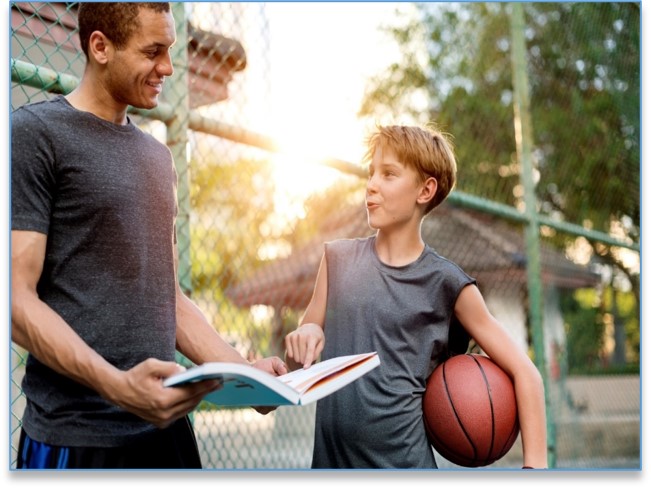Teaching Young Athletes the Skills of “Learning to Learn”
Effective coaches not only teach sports skills, they also help young athletes learn strategies for faster learning. Many athletes learn slowly because they lack skills relating to how to learn. They may have short attention spans, be easily distracted, focus more on the coach’s mood than his instructions, or fail to ask questions when confused about instructions. Effective coaches try to develop progressions that teach young athletes the required skills for efficient learning. This strategy is called “learning to learn.” What follows are three simple, positive coaching strategies that help create efficient practice sessions, nurture motivation and aid in the mastery and development of skills in young athletes.
1. Teach Paying Attention
Telling a young athlete to “pay attention” is not the same as teaching them the skills of paying attention. A truism when working with young athletes is that they are often very distractible and have difficulty, at least initially, maintaining focus. Effective coaches give instruction that is light on verbal instruction and heavy with demonstrations and participation. If an athlete rarely looks at you and gives the impression that he does not care, avoid ineffective statements such as “Can’t you ever pay attention?” or “Don’t you care?” The first is an overstatement, while the second questions motives, which are often difficult to correctly identify. Encourage them to show that they are paying attention by coaching them to maintain eye contact with you while you are providing both group and individual instruction. Eye contact provides you with feedback concerning whether your instruction is understood or accepted. A frown, a quizzical look, a nod of understanding can all help you be aware of the effectiveness – or the lack of effectiveness – of your instruction. Be direct and say:
“When you don’t look at me, I don’t know if you’re listening.”
“When you make eye contact with me, I know you’re listening, and we can continue to work together.”
Ask questions to see if they understand what you just taught. If they fail to understand, encourage them to ask questions rather than scolding them for remaining silent or not listening.
2. Teach Working Independently Progressively
Encourage beginners to work independently1 for brief periods of time and then gradually increase the time during which they must continue to focus and concentrate without direct supervision. Start by giving young athletes simple work assignments that use skills that they have already mastered but which require only short periods of independence; then gradually increase the length and complexity of those assignments while complementing the athletes for “staying focused.”
3. Thinking and Making Judgments
Perhaps the most important skill of learning to learn is to think and make decisions. All sports require decision making but some (open skills) require more decision making in competition than others (fixed skills). Encourage athletes to make decisions about what will help them improve. For example, set aside one practice a week for athletes to work on “what they think they need most to improve their game” — not their favorite skills or their worst techniques, but rather what skill that they judge to be the one they could improve the fastest in the shortest period of time or what would make the biggest improvement in their competitive performance. If their judgments do not initially match yours as the coach, encourage them to think more critically but do not become critical of their judgments. Your job is to improve their judgment, so they become actively involved in their own improvement.
A powerful technique for teaching young athletes to think is called Facilitative Questioning2. One form of facilitative questioning is: “Ask, Suggest, Tell.” You pose an open-ended question followed by increasingly directive prompts to athletes who initially may be too young, immature, or inexperienced to respond appropriately. If after being asked a question, they are unable to answer, shift to giving them two or three suggestions from which them mat choose the answer. If they are reluctant to make a choice or choose incorrectly, shift to telling them the correct answer but only after giving them a reasonable opportunity to choose.
Example: Teaching Decision Making for defending in soccer
Ask – “Where’s the best position to guard your man?”
If no answer or weak answers, shift to provide a simple choice between two or three options.
Suggest – “Should you mark him goal side or away from the goal?”
If the athlete still shows a lack of understanding and judgment or is too shy to respond, shift to the traditional command style of coaching using explicit directions.
Tell – “Mark your man goal side.”
This simple technique provides athletes with real opportunities to think and make decisions, yet still provides the coach with control over the teaching situation. Asking the original question promotes thinking, but when inappropriate or ineffective answers are given, the coach can shift from “ask” to “suggest” and ultimately to “tell.” Coaches who rely primarily on telling young athletes what to do teach athletes to follow directions, an important skill, but quite different from teaching them to think and make judgements.
1 This technique does not mean the young athletes work unsupervised!
2 Elias, M. J. & Clabby, J. F. (1992). Building Social Problem-Solving Skills: Guidelines from a school-based Program. San Francisco: Jossey-Bass
